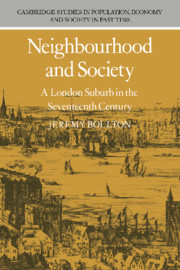Book contents
- Frontmatter
- Contents
- List of figures
- List of tables
- Preface
- Abbreviations
- 1 Introduction
- 2 The demographic background
- 3 Earning a living in early seventeenth-century Southwark
- 4 Wealth and social structure
- 5 Household structure and the household economy
- 6 Power, status and social mobility
- 7 Residential patterns and property ownership
- 8 The dynamics of a local community
- 9 Social relationships in the urban neighbourhood
- 10 The institutional structure of the neighbourhood
- 11 Conclusion: neighbourhood and society in seventeenth-century London
- Bibliography
- Index
8 - The dynamics of a local community
Published online by Cambridge University Press: 19 October 2009
- Frontmatter
- Contents
- List of figures
- List of tables
- Preface
- Abbreviations
- 1 Introduction
- 2 The demographic background
- 3 Earning a living in early seventeenth-century Southwark
- 4 Wealth and social structure
- 5 Household structure and the household economy
- 6 Power, status and social mobility
- 7 Residential patterns and property ownership
- 8 The dynamics of a local community
- 9 Social relationships in the urban neighbourhood
- 10 The institutional structure of the neighbourhood
- 11 Conclusion: neighbourhood and society in seventeenth-century London
- Bibliography
- Index
Summary
A number of recent studies have suggested that considerable residential mobility was a feature of pre-industrial urban society. The residential patterns reconstructed so labouriously in the previous chapter, therefore, may well give a misleading impression of stability. In fact many of the maps and diagrams produced by urban geographers should be interpreted not as unchanging and rigid patterns but as snapshots of a shifting population, constantly redistributing itself according to various social and economic imperatives. An analysis of such movement is crucial to an adequate understanding of pre-industrial urban society.
The degree of residential mobility and stability is particularly important for those interested in the existence or otherwise of urban ‘communities’. Many authorities believe that the population turnover and sheer size of London produced ‘anomie’ in a manner similar to that described for nineteenth- and twentieth-century cities. Peter Burke has suggested recently that, at whatever date, ‘it seems reasonable to suggest that it is the large city, the city of 100,000 inhabitants or more, which engenders privacy and anonymity’. Lawrence Stone has described the population turnover in seventeenth-century London as resembling ‘nothing so much as Los Angeles in the mid-twentieth century’ and Christopher Hill sees London as a place of refuge, one of the ‘vast anonymous cities and towns’ in which masterless men escaped from the bonds of feudal lordship.
- Type
- Chapter
- Information
- Publisher: Cambridge University PressPrint publication year: 1987

